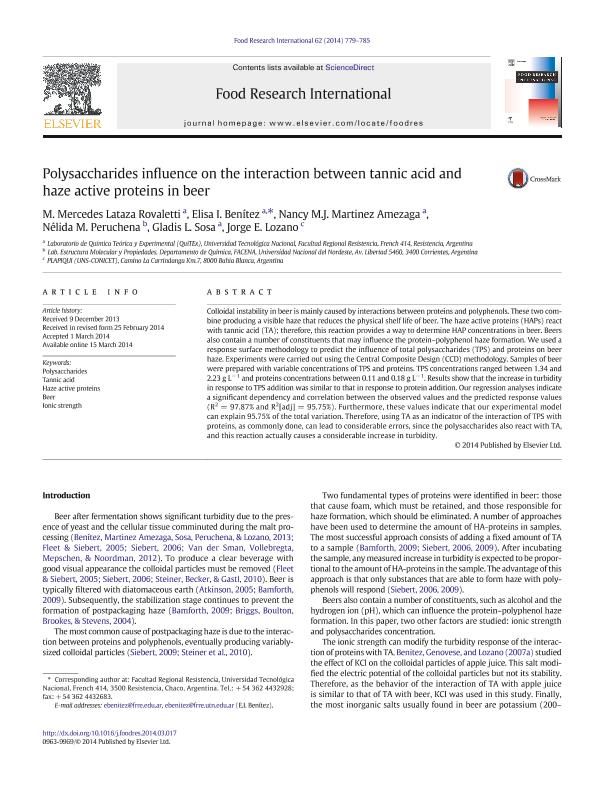Mostrar el registro sencillo del ítem
dc.contributor.author
Lataza Rovaletti, Mercedes
dc.contributor.author
Benitez, Elisa Ines

dc.contributor.author
Martinez Amezaga, Nancy María Jimena

dc.contributor.author
Peruchena, Nelida Maria

dc.contributor.author
Sosa, Gladis Laura

dc.contributor.author
Lozano, Jorge Enrique

dc.date.available
2018-02-26T20:10:23Z
dc.date.issued
2014-08
dc.identifier.citation
Lataza Rovaletti, Mercedes; Benitez, Elisa Ines; Martinez Amezaga, Nancy María Jimena; Peruchena, Nelida Maria; Sosa, Gladis Laura; et al.; Polisaccharides influence on the interaction between tannin acid and haze active proteins in beer; Elsevier Science; Food Research International; 62; 8-2014; 779-785
dc.identifier.issn
0963-9969
dc.identifier.uri
http://hdl.handle.net/11336/37158
dc.description.abstract
Colloidal instability in beer is mainly caused by interactions between proteins and polyphenols. These two combine producing a visible haze that reduces the physical shelf life of beer. The haze active proteins (HAPs) react with tannic acid (TA); therefore, this reaction provides a way to determine HAP concentrations in beer. Beers also contain a number of constituents that may influence the protein-polyphenol haze formation. We used a response surface methodology to predict the influence of total polysaccharides (TPS) and proteins on beer haze. Experiments were carried out using the Central Composite Design (CCD) methodology. Samples of beer were prepared with variable concentrations of TPS and proteins. TPS concentrations ranged between 1.34 and 2.23gL-1 and proteins concentrations between 0.11 and 0.18gL-1. Results show that the increase in turbidity in response to TPS addition was similar to that in response to protein addition. Our regression analyses indicate a significant dependency and correlation between the observed values and the predicted response values (R2=97.87% and R2[adj]=95.75%). Furthermore, these values indicate that our experimental model can explain 95.75% of the total variation. Therefore, using TA as an indicator of the interaction of TPS with proteins, as commonly done, can lead to considerable errors, since the polysaccharides also react with TA, and this reaction actually causes a considerable increase in turbidity.
dc.format
application/pdf
dc.language.iso
eng
dc.publisher
Elsevier Science

dc.rights
info:eu-repo/semantics/openAccess
dc.rights.uri
https://creativecommons.org/licenses/by-nc-sa/2.5/ar/
dc.subject
Beer
dc.subject
Haze Active Proteins
dc.subject
Ionic Strength
dc.subject
Polysaccharides
dc.subject
Tannic Acid
dc.subject.classification
Otras Ingeniería Química

dc.subject.classification
Ingeniería Química

dc.subject.classification
INGENIERÍAS Y TECNOLOGÍAS

dc.title
Polisaccharides influence on the interaction between tannin acid and haze active proteins in beer
dc.type
info:eu-repo/semantics/article
dc.type
info:ar-repo/semantics/artículo
dc.type
info:eu-repo/semantics/publishedVersion
dc.date.updated
2018-01-11T14:38:22Z
dc.journal.volume
62
dc.journal.pagination
779-785
dc.journal.pais
Países Bajos

dc.journal.ciudad
Amsterdam
dc.description.fil
Fil: Lataza Rovaletti, Mercedes. Universidad Tecnológica Nacional. Facultad Regional Resistencia. Departamento de Ingeniería Química. Laboratorio de Química Teórica y Experimental; Argentina
dc.description.fil
Fil: Benitez, Elisa Ines. Universidad Tecnológica Nacional. Facultad Regional Resistencia. Departamento de Ingeniería Química. Laboratorio de Química Teórica y Experimental; Argentina
dc.description.fil
Fil: Martinez Amezaga, Nancy María Jimena. Universidad Tecnológica Nacional. Facultad Regional Resistencia. Departamento de Ingeniería Química. Laboratorio de Química Teórica y Experimental; Argentina. Consejo Nacional de Investigaciones Científicas y Técnicas. Centro Científico Tecnológico Conicet - Nordeste; Argentina
dc.description.fil
Fil: Peruchena, Nelida Maria. Consejo Nacional de Investigaciones Científicas y Técnicas. Centro Científico Tecnológico Conicet - Nordeste; Argentina. Universidad Nacional del Nordeste. Facultad de Ciencias Exactas y Naturales y Agrimensura. Departamento de Química. Laboratorio de Estructura Molecular y Propiedades; Argentina
dc.description.fil
Fil: Sosa, Gladis Laura. Universidad Tecnológica Nacional. Facultad Regional Resistencia. Departamento de Ingeniería Química. Laboratorio de Química Teórica y Experimental; Argentina
dc.description.fil
Fil: Lozano, Jorge Enrique. Consejo Nacional de Investigaciones Científicas y Técnicas. Centro Científico Tecnológico Conicet - Bahía Blanca. Planta Piloto de Ingeniería Química. Universidad Nacional del Sur. Planta Piloto de Ingeniería Química; Argentina
dc.journal.title
Food Research International

dc.relation.alternativeid
info:eu-repo/semantics/altIdentifier/url/http://www.sciencedirect.com/science/article/pii/S0963996914001756
dc.relation.alternativeid
info:eu-repo/semantics/altIdentifier/doi/http://dx.doi.org/10.1016/j.foodres.2014.03.017
Archivos asociados
